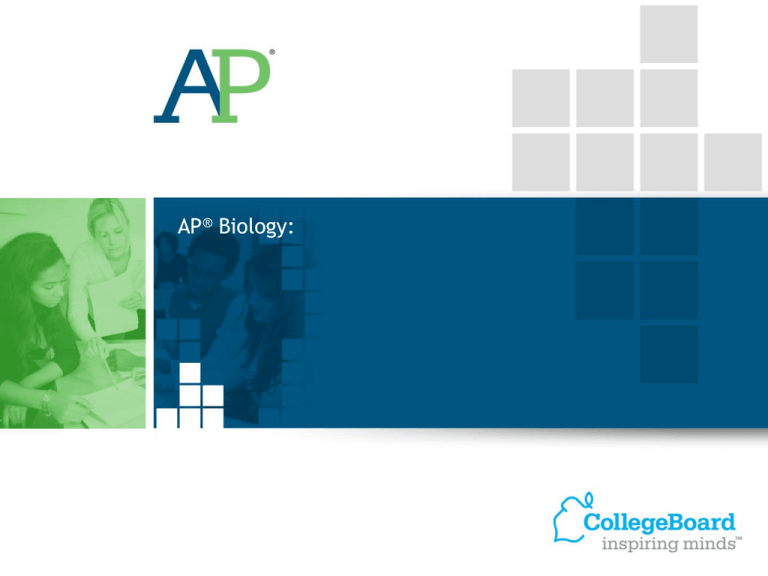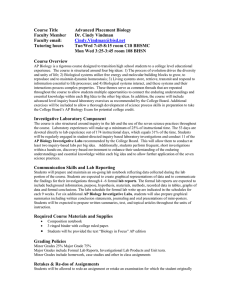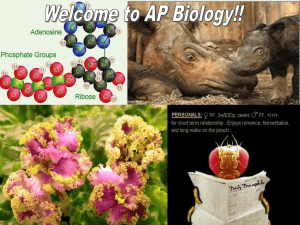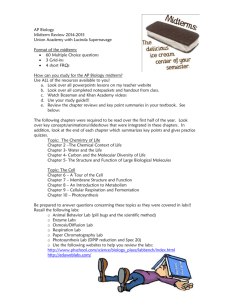College Board - AP Higher Ed Template
advertisement

AP® Biology: Goals of the AP Biology Revision Working Directly With Experts From Colleges and High Schools, the College Board Has Created a Revised AP Biology Course That: Supports the awarding of college credit/placement for qualifying student exam performance Provides students the opportunity to prepare for success in sequent college courses in biology The New Curriculum Framework Supports and Furthers Conceptual Knowledge 4 Big Ideas Enduring Understandings Science Practices: Science Inquiry & Reasoning Essential Knowledge Learning Objectives AP Biology Curriculum Is Framed Around Four Big Ideas BIG IDEA BIG IDEA BIG IDEA BIG IDEA 1 The process of evolution drives the diversity and unity of life. 2 Biological systems utilize energy and molecular building blocks to grow, reproduce, and maintain homeostasis. 3 4 Living systems retrieve, transmit, and respond to information essential to life processes. Biological systems interact, and these interactions possess complex properties. EXAMPLE Building Enduring Understandings For each of the four Big Ideas, there is a set of Enduring Understandings which incorporates core concepts that students should retain from these learning experiences BIG IDEA 1 The process of evolution drives the diversity and unity of life. Enduring Understanding 1.A: Change in the genetic makeup of a population over time is evolution Enduring Understanding 1.B: Organisms are linked by lines of descent from common ancestry Enduring Understanding 1.C: Life continues to evolve within a changing environment Enduring Understanding 1.D: The origin of living systems is explained by natural processes EXAMPLE Building Essential Knowledge Each Enduring Understanding is followed by statements of the Essential Knowledge students must develop in the course BIG IDEA 1 The process of evolution drives the diversity and unity of life. Enduring Understanding 1.A: Change in the genetic makeup of a population over time is evolution Essential Knowledge1.A.1: Natural selection is a major mechanism of evolution a. According to Darwin’s Theory of Natural Selection, competition for limited resources results in differential survival . Individuals with more favorable phenotypes are more likely to survive and produce more offspring, thus passing traits to subsequent generations b. Evolutionary fitness is measured by reproductive success c. Genetic variation and mutation play roles in natural selection. A diverse gene pool is important for the survival of a species in a changing environment Emphasis on Science Practices The science practices enable students to establish lines of evidence and use them to develop and refine testable explanations and predictions of natural phenomena SCIENCE PRACTICES 1.0 The student can use representations and models to communicate scientific phenomena and solve scientific problems 2.0 The student can use mathematics appropriately 3.0 The student can engage in scientific questioning to extend thinking or to guide investigations within the context of the AP course 4.0 The student can plan and implement data collection strategies appropriate to a particular scientific question 5.0 The student can perform data analysis and evaluation of evidence 6.0 The student can work with scientific explanations and theories 7.0 The student is able to connect and relate knowledge across various scales, concepts, and representations in and across domains EXAMPLE Clearly Articulated Science Practices Underpin the Entire Course SCIENCE PRACTICES 6.0 The student can work with scientific explanations and theories. 6.1 The student can justify claims with evidence 6.2 The student can construct explanations of phenomena based on evidence produced through scientific practices 6.3 The student can articulate the reasons that scientific explanations and theories are refined or replaced. 6.4 The student can make claims and predictions about natural phenomena based on scientific theories and models. 6.5 The student can evaluate alternative scientific explanations An Example of Integrating the Concept, Content, and the Science Practice Content + Science Practice Learning Objective Essential Knowledge 1.B.2 Phylogenetic trees and cladograms are graphical representations (models) of evolutionary history that can be tested Science Practice 5.3 The student can evaluate the evidence provided by data sets in relation to a particular scientific question Learning Objective (1.B.2 & 5.3) The student is able to evaluate evidence provided by a data set in conjunction with a phylogenetic tree or a simple cladogram to determine evolutionary history and speciation The New Course Emphasizes Inquiry-Based and Student-Directed Labs Topic Previously Now Primary Question A primary question framed the lab Alignment to Big Ideas Not as clearly tied to the curriculum Students generate their own questions for investigation Labs are clearly tied to Big Ideas, enduring understandings, science practices, and the learning objectives Experiments Experiments were teacher-directed Students design and conduct their own experiments, based on investigative questions they pose for themselves Variables Students are told which variables to investigate Each lab provided clear steps to follow Tables and graphs were provided for the students to fill in Students choose which variables to investigate Students design their own experimental procedures Students construct their own tables and graphs for presentations Students were given specific questions to answer Students determine how to provide their conclusion Steps Tables and Graphs Providing Conclusions 10 AP Biology Investigative Labs: An InquiryBased Approach 13 inquiry-based lab investigations Investigations are broken up by big ideas and map directly to the AP Biology curriculum framework Each investigation provides guidance to the teacher pre-, during, and post-investigation Many of the investigations provide suggestions for extension AP Biology Investigative Labs: An InquiryBased Approach Big Idea 1 – Artificial Selection – Mathematical Modeling: Hardy-Weinberg – Comparing DNA Sequences to Understand Evolutionary Relationships with BLAST Big Idea 2 – Diffusion and Osmosis – Photosynthesis – Cellular Respiration AP Biology Investigative Labs: An InquiryBased Approach Big Idea 3 – Cell Division: Mitosis and Meiosis – Biotechnology: Bacterial Transformation – Biotechnology: Restriction Enzyme Analysis of DNA Big Idea 4 – – – – Energy Dynamics Transpiration Fruit Fly Behavior Enzyme Activity AP Biology New Exam Design Section Information: Item Types & Weight Multiple Choice + Grid-ins (50% of exam weight) Question Types and Distribution 63 multiple choice 6 grid-in questions (New type: mathematical manipulation/calculation. Students will write and bubble in numerated answer) Timing 90m Ten Minutes Required Reading Time in Advance of the Free Response Section Free Response (50% of exam weight) 2 long free response questions, 1 of which connects to the lab experience (40 minutes total – 20 minutes each) 25% of Free Response Exam Weight 6 short free response questions (40 minutes total – approx. 6.5 min each) 25% of Free Response Exam Weight 80 minutes + 10minute reading period EXAMPLE Example of a Multiple Choice Question Integrating Concept, Content and Science Practice Two flasks with identical medium containing nutrients and glucose are inoculated with yeast cells that are capable of both anaerobic and aerobic respiration. Culture 1 is then sealed to prevent fresh air from reaching the culture; culture 2 is loosely capped to permit air to reach the culture. Both flasks are periodically shaken. Which of the following best predicts which culture will contain more yeast cells after one week, and most accurately justifies that prediction? A. Culture 1, because fresh air is toxic to yeast cells and will inhibit their growth B. Culture 1, because fermentation is a more efficient metabolic process than cellular respiration C. Culture 2, because fresh air provides essential nitrogen nutrients to the culture D. Culture 2, because oxidative cellular respiration is a more efficient metabolic process than fermentation MULTIPLE CHOICE EXAMPLE Example of a Multiple Choice Question Integrating Concept, Content and Science Practice Animal Feathers Fur/Mammary Glands Jaws Lungs Claws Nails Lizard X X X Mouse X X X X Chimp X X X X Perch X Pigeon X X X Salamander X X X Hagfish X MULTIPLE CHOICE EXAMPLE And Here Is the Exam Question… Assume that the cladogram shows the correct ancestral relationships between the organisms listed. Which of the following describes an error in the data table? A. Perch have swim bladders, and therefore the table should indicate the presence of lungs. B. Salamanders should not show claws or nails in the data table. C. Pigeons produce a nutritious milk-like substance for their young, and therefore the data table should indicate the presence of mammary glands. D. Hagfish are the animals least like chimps, but since they are fish, the data table should indicate the presence of jaws. EXAMPLE Short Free Response Question BIG IDEA 1 Currently, all living organisms are classified into one of three domains: Bacteria, Archaea, and Eukarya. In a sentence or two, provide two pieces of evidence that justify a common origin for the three domains. BIG IDEA 2 Oxygen can diffuse into cells by passing between plasma membrane lipids. In a sentence or two, explain why ions, such as Na+, cannot pass between membrane lipids. EXAMPLE Another Short Free Response Question… BIG IDEA 3 The role of tRNA in the process of translation was investigated by the addition of tRNA with attached radioactive leucine to an in vitro translation system that included mRNA and ribosomes. The results are shown by the graph. Describe in one or two sentences how this figure justifies the claim that the role of tRNA is to carry amino acids that are then transferred from the tRNA to growing polypeptide chains. EXAMPLE Short Free Response Questions BIG IDEA 4 The activity rate of an enzyme was measured at various temperatures based on the amount of substrate, in micromoles, produced per square meter of reaction surface per second. The table below shows the data collected. In two or three sentences, indicate the nature of the relationship between enzyme structure/function and environment temperature that explains the data shown in the table.




